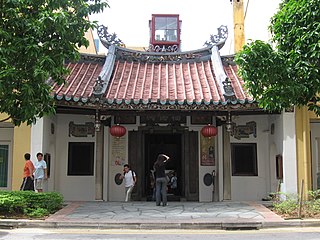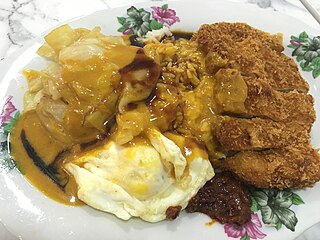 W
WAmitabha Buddhist Centre is a Buddhist institution in Geylang, Singapore. It is affiliated with the Foundation for the Preservation of the Mahayana Tradition (FPMT), an international non-profit organisation, founded by Lama Thubten Yeshe.
 W
WChinese Garden is a park in Jurong East, Singapore. Built in 1975 by the JTC Corporation and designed by Prof. Yuen-chen Yu, an architect from Taiwan, the Chinese Garden’s concept is based on Chinese gardening art. The main characteristic is the integration of architectural features with the natural environment. The Chinese Garden is modeled along the northern Chinese imperial style of architecture and landscaping. It is located next to Chinese Garden MRT station and connected to the adjacent Japanese Garden by a bridge. Along with Japanese Garden, the two gardens are collectively known as the Jurong Gardens.
 W
WThe Chinese High School was a former independent school in Singapore offering secondary education. The school merged with Hwa Chong Junior College on 1 January 2005 to form the integrated Hwa Chong Institution.
 W
WIn Chinese communities, especially in China, Hong Kong, Malaysia, and Singapore, wedding door games are challenges set up by the bridesmaids for the groom as a ceremonial demonstration of the groom's love for the bride. These games typically take place in the morning of the wedding at the bride's family home, before the groom is allowed to receive the bride in the bride's room. The groom typically receives the help of his groomsmen in completing the tasks.
 W
WFo Shan Ting Da Bo Gong Temple is a Chinese temple in Singapore located in Pulau Ubin, and was founded around 1869. It is one of the three temples in Singapore that has a permanent theatre for Chinese Opera and Getai performances during festivals.
 W
WThe Fuk Tak Chi Temple was one of the oldest former temple in Singapore which has turned into a museum, built in 1824 by Cantonese and Hakka immigrants from Kwong Wai Siew (广惠肇三府). Two other Hakka clans, Fong Yun Thai and Ying Fo Fui Kun joined in 1854 after contributing to the temple's rebuilding project. Dedicated to Tua Pek Kong, it is a Chinese folk religion temple which caters to the religious needs of both Chinese folk religionists and Taoists.
 W
WHainanese chicken rice is a dish of poached chicken and seasoned rice, served with chilli sauce and usually with cucumber garnishes. It was created by immigrants from Hainan in southern China and adapted from the Hainanese dish Wenchang chicken. It is considered one of the national dishes of Singapore and is most commonly associated with Singaporean cuisine. The dish is also seen throughout Southeast Asia, particularly Indonesia and Malaysia where it is a culinary staple.
 W
WHainanese curry rice is a Chinese Singaporean dish consisting of steamed white rice smothered in a mess of curries and gravy, characteristically accompanied by curry chicken, pork chop, chap chye and kong bak. It originates in Singaporean cuisine and is not thought of as part of the cuisine of Hainan, China.
 W
WHong San See is a Chinese temple in Singapore, and is located at Mohamed Sultan Road in the River Valley Planning Area, within the Central Area.
 W
WThe Kong Meng San Phor Kark See Monastery, is a Buddhist temple and monastery in Bishan, Singapore. Built by Zhuan Dao in the early 20th century to propagate Buddhism and to provide lodging for monks, this monastery is the largest Buddhist temple in Singapore. It is the parent organization of the Buddhist College of Singapore founded in 2006. It is one of the two private crematoria, while the other one is Tse Toh Aum Temple.
 W
WKwan Im Thong Hood Cho Temple is a traditional Chinese temple situated at 178 Waterloo Street in Singapore. The temple is of significance to the Chinese in Singapore, and is believed to bring worshippers good luck after praying to the Kuan Yin (觀世音菩薩), or Avalokiteśvara, the Goddess of Mercy. The temple is also involved in charity work, contributing to several health and educational organisations.
 W
WNanyang University was a university in Singapore from 1956 to 1980. During its existence, it was Singapore's only private university in the Chinese language. In 1980, Nanyang University was merged with the University of Singapore to form the National University of Singapore (NUS). It was only until 2005 that another private school in Singapore, SIM University was established.
 W
WPoh Ern Shih is located on a small hilltop at Chwee Chian Road, off Pasir Panjang Road, on Singapore's southern coast. The Buddhist temple was built as a memorial to those who lost their lives during the Battle of Pasir Panjang in 1942, villagers as well as Allied and Japanese soldiers. The temple's first abbot, Sumangalo, an American Theravadin monk, was the first Westerner to be appointed abbot of a Buddhist temple in Singapore.
 W
WShin Min Daily News is a Singapore Chinese-language afternoon newspaper currently published by Singapore Press Holdings (SPH). First started on 18 March 1967, by Singapore businessman Liang Runzhi (梁潤之) and the renowned Hong Kong writer Louis Cha as an offshoot of Hong Kong's Ming Pao, it featured exclusive serializations of some of Cha's wuxia novels in its early days. In the early 1980s, Cha sold his shares in the paper after the Singapore government ruled that foreigners could only hold up to 3% of shares in locally based papers.
 W
WThe development of Singapore's Chinese characters can be divided into three periods:Before 1969 : Used Traditional Chinese characters 1969–1976: The Ministry of Education promulgated the Table of Simplified Characters, which differed from the Chinese Character Simplification Scheme of the People's Republic of China After 1976: fully adopted the Simplified Chinese characters of the People's Republic of China. In 1977, the second attempt to simplify the characters was stopped, ending the long period of confusion associated with simplification.
 W
WThe Singapore Chinese Football Club is a local football organisation established in Singapore in 1911. Initially set up to promote football amongst the Chinese community in colonial Singapore, its focus now is to advance the interests of Singapore football, with an added emphasis on young players.
 W
WSingapore Chinese Girls' School (SCGS) is an independent girls' school in Bukit Timah, Singapore, located next to Stevens MRT station. Founded in 1899, it is one of the oldest institutions in Singapore. It offers a six-year primary education in its primary school section, as well as a four-year secondary education in its secondary school section, which was among the first secondary schools in Singapore to be accorded independent school status in 1989. Since 2013, it has partnered with Eunoia Junior College for a six-year Integrated Programme, which allows its secondary school students to proceed to Eunoia for Years 5 and 6 and take the Singapore-Cambridge GCE Advanced Level examinations at the end of Year 6.
 W
WSingapore Chinese Orchestra SCO is Singapore's only professional Chinese orchestra. Inaugurated in 1997, the 85-musician orchestra took on the twin role of preserving traditional arts and culture and establishing new frontiers through the incorporation of Nanyang music elements in its repertoire.
 W
WSiong Leng Musical Association or Siong Leng is a Nanyin musical group from Singapore. Siong Leng is known for its contribution to preserve and promote Nanyin and Liyuan Opera, the arts of Southern Min people.
 W
WSiong Lim Temple, also known as Lian Shan Shuang Lin Monastery, is a Buddhist monastery located in Toa Payoh, Singapore, next to the Pan Island Expressway. The temple was founded in 1898, but the construction of the premises only began in 1902 by Low Kim Pong and was completed in 1907. The monastery was gazetted as a national monument in 1980 and subsequently underwent a decade-long restoration that began in 1991. The temple now boasts a seven storey gold-topped pagoda which is a replica of the 800-year-old Shanfeng temple pagoda in Fujian. It has a Columbarium for Tomb Sweeping Day.
 W
WTan Si Chong Su, or Ancestral Hall of the Tan Clan, is a Chinese temple in Singapore. It is located on Magazine Road in the Singapore River Planning Area within Singapore's central business district. It was constructed between 1876 and 1878 as the ancestral temple for those with the same Tan surname, based on the premise that Chinese people with the same surname would share a common ancestry and therefore belong to the same clan. The Temple also dedicated to Kai Zhang Sheng Wang (開漳聖王),the Patron Deity and founder of Zhangzhou City in China.
 W
WThe Tou Mu Kung Temple 斗母宮 is a Taoist temple situated on Upper Serangoon Road, Singapore. Worshipping the Empress Registrar of Birth or Doumu (斗母) and Nine Emperor (九皇大帝) Deities, the temple has both Taoist and Buddhist influences.
 W
WYueh Hai Ching Temple, also known as the Wak Hai Cheng Bio from its Teochew pronunciation, is a Chinese temple in Singapore located in Raffles Place in Singapore's central business district. The temple, whose name literally means "Temple of the Calm Cantonese Sea", was the first stop for Chinese immigrants to Singapore in the early 19th century.